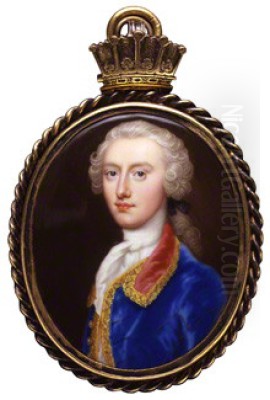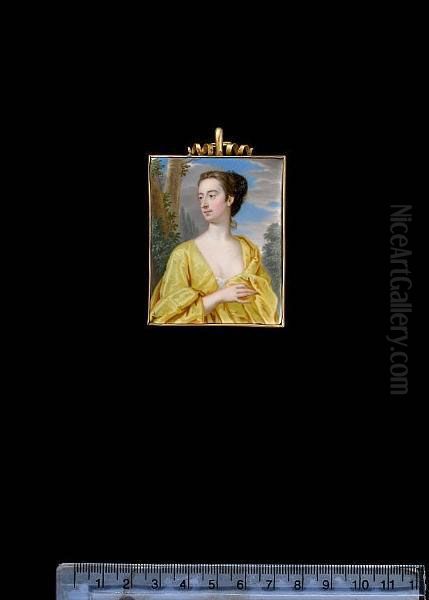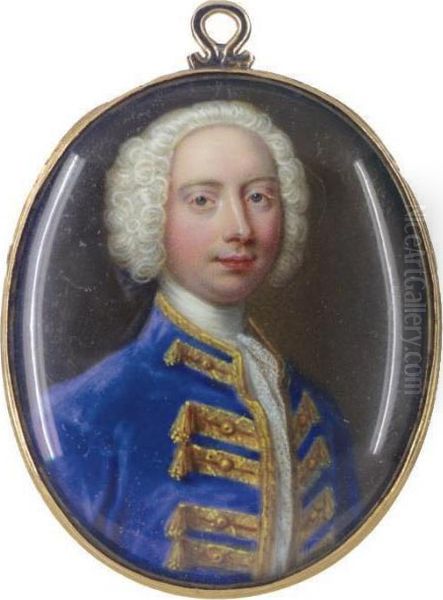
Christian Friedrich Zincke stands as a pivotal figure in the history of 18th-century European art, particularly celebrated for his mastery of the demanding art of enamel miniature portraiture. Born in Dresden, Saxony, around 1683 or 1684, he emerged from a background steeped in fine craftsmanship, which would profoundly shape his artistic trajectory. His journey from Germany to England, and his subsequent rise to prominence, marks a fascinating chapter in the cross-cultural artistic exchanges of the era. Zincke's oeuvre not only reflects his exceptional technical skill but also provides an intimate glimpse into the personalities and social echelons of Georgian England.
Early Life and Artistic Foundations in Dresden
Christian Friedrich Zincke's formative years were spent in Dresden, a vibrant cultural and artistic hub in the Electorate of Saxony. His father was a goldsmith, an occupation that demanded precision, an understanding of metallurgy, and a keen eye for detail. It was within this environment that young Zincke received his initial training, likely acquiring foundational skills in metalworking and decorative arts. This early exposure to the meticulous nature of goldsmithing would prove invaluable for his later specialization in enamel painting, a technique that shares many procedural similarities with fine metalcraft.
Beyond the familial workshop, Zincke sought formal artistic instruction. He is recorded as having studied under Heinrich Christoph Fehling (1654–1725), a respected painter in Dresden. Fehling, who had himself trained in Italy and later became a court painter, would have provided Zincke with a solid grounding in portraiture and painting techniques prevalent at the time. This academic training, combined with his practical skills from goldsmithing, created a versatile foundation upon which Zincke would build his specialized career. The artistic atmosphere of Dresden, with its rich collections and patronage from the Saxon Electors, undoubtedly further nurtured his burgeoning talent.
The Move to England and Apprenticeship under Charles Boit

The year 1706 marked a significant turning point in Zincke's life and career. He relocated to England, a country that was becoming an increasingly important center for the arts and a lucrative market for skilled artisans. His move was reportedly at the invitation of Charles Boit (c. 1662–1727), a Swedish-born artist who was, at that time, the preeminent enamel painter in England. Boit himself had an international career, having worked in various European courts before settling in London, where he enjoyed royal patronage, including from Queen Anne and later, commissions from figures like Peter the Great of Russia.
Under Boit's tutelage, Zincke immersed himself in the intricate art of painting in enamels. This technique involved fusing powdered glass, colored with metallic oxides, onto a metal substrate (usually copper, gold, or silver) through successive firings at high temperatures. It was a challenging medium, demanding immense patience, precision, and a deep understanding of how colors would transform in the kiln. Boit, known for his ambitious, sometimes overly large, enamel pieces, provided Zincke with the specialized knowledge required to master this difficult art form. The master-apprentice relationship was crucial, allowing Zincke to refine his skills and understand the nuances of the English art market.
Ascendancy as a Leading Enamel Miniaturist
Charles Boit's career, despite its initial successes, was eventually marred by financial difficulties, partly due to overly ambitious projects like a very large enamel of the Battle of Blenheim that was never completed. Boit left England around 1714. This departure created a vacuum in the field of high-quality enamel portraiture, a vacuum that Christian Friedrich Zincke was perfectly positioned to fill. Having thoroughly absorbed Boit's techniques and perhaps learned from his master's missteps, Zincke rapidly established himself as the foremost enamel painter in England.
His reputation grew steadily, and he soon attracted a distinguished clientele, including members of the British aristocracy and the Royal Family. He was appointed Cabinet Painter to Frederick, Prince of Wales, a significant patron of the arts, and also received commissions from King George II and Queen Caroline. This royal patronage solidified his status and ensured a steady stream of commissions. Unlike Boit, Zincke focused primarily on smaller, more intimate portrait miniatures, which were highly fashionable as personal keepsakes, diplomatic gifts, or adornments for jewelry and snuffboxes. His meticulous craftsmanship and ability to capture a sitter's likeness with flattering elegance made his work highly sought after.
Artistic Style and Technical Virtuosity

Zincke's artistic style is characterized by its refined detail, vibrant and enduring colors, and the smooth, luminous quality of the enamel surface. He possessed an exceptional ability to render flesh tones with a subtle graduation of color, giving his portraits a lifelike warmth. His depiction of fabrics, lace, and jewelry was equally meticulous, showcasing the textures and richness of his sitters' attire. A distinctive feature often noted in his work, particularly in his later period, was the use of two distinct enamel colors, such as a subtle purple and an orange hue, on the lips, adding a particular vibrancy.
His treatment of the eyes was another hallmark of his skill, imbuing his subjects with a sense of presence and character. The backgrounds of his miniatures were typically simple, often a plain, graduated tone, which served to emphasize the sitter. Zincke usually worked on copper bases, applying multiple layers of enamel and firing the piece repeatedly to achieve the desired depth and brilliance of color. Each firing was a risk, as the enamel could crack, colors could shift unexpectedly, or imperfections could arise. Zincke's consistent success in producing flawless pieces speaks volumes about his technical mastery. His miniatures were often set in ornate gold frames, lockets, or the lids of boxes, further enhancing their status as precious objects.
Notable Works and Patronage
Throughout his long and productive career, Zincke created a vast number of miniature portraits. While many were of private individuals whose identities are now lost, several significant works remain, often depicting prominent figures of the era. His portrait of Sir John Churchill, 1st Duke of Marlborough (circa 1715), is a fine example of his earlier work, capturing the resolute character of the famed military commander. Such portraits were not merely personal mementos but could also carry political weight, serving as symbols of allegiance or commemoration.
His portraits of the royal family, including King George II, Queen Caroline, and their children, particularly Frederick, Prince of Wales, and his wife Augusta, Princess of Wales, are among his most important commissions. These royal portraits were often replicated, with slight variations, to be distributed as gifts, a common practice in courtly circles. Another charming example of his work is A Young Lady, which showcases his delicate rendering of feminine beauty and intricate details like pearl adornments. The sheer volume of his output indicates his immense popularity and the high demand for his skills among the British elite. His sitters included leading politicians, aristocrats, military figures, and society beauties, all eager to be immortalized by his skilled hand.
Contemporaries and the Artistic Milieu
Zincke operated within a vibrant artistic scene in 18th-century London. While he dominated the field of enamel miniatures, other forms of portraiture also flourished. Sir Godfrey Kneller (1646–1723) had been the leading large-scale portrait painter in oils at the beginning of Zincke's English career, establishing a style that influenced many. After Kneller, painters like Charles Jervas (c. 1675–1739) and later, William Hogarth (1697–1764), though known for different genres, were also significant figures in London's art world.
In the realm of miniatures, before enamel gained such prominence for its durability, artists like Bernard Lens III (1682–1740) were highly regarded for their work in watercolor on ivory or vellum. Lens, a contemporary of Zincke, also enjoyed royal patronage and was a drawing master to the royal children. The Italian pastellist Rosalba Carriera (1673–1757) made a sensational, though brief, visit to London in the 1720s, popularizing the pastel medium and influencing English taste. Later in Zincke's career, artists like Jean-Étienne Liotard (1702–1789), a Swiss artist who also worked in enamel and pastel, spent time in England and achieved considerable success.
Zincke's relationship with his former master, Charles Boit, is noteworthy. While Boit provided the initial training, Zincke's consistent quality and business acumen allowed him to surpass his teacher in sustained success in England. The legacy of earlier miniaturists, such as the Elizabethan masters Nicholas Hilliard (c. 1547–1619) and Isaac Oliver (c. 1565–1617), and the 17th-century virtuoso Samuel Cooper (1609–1672), had established a strong tradition of miniature painting in England, upon which artists like Zincke built, albeit with the more modern and robust technique of enameling, which itself had earlier European masters like Jean Petitot (1607-1691).
Influence and Pupils
Christian Friedrich Zincke was not only a prolific artist but also a teacher who passed on his specialized knowledge. His most notable pupil was Jeremiah Meyer (1735–1789), another German-born artist who came to England. Meyer, under Zincke's guidance, became an accomplished miniaturist in both enamel and watercolor on ivory. He went on to become a founding member of the Royal Academy of Arts in 1768 and was appointed Miniature Painter to King George III and Enamel Painter to Queen Charlotte, effectively succeeding Zincke as the leading figure in the field after Zincke's retirement.
The influence of Zincke's style can also be seen in the work of other, lesser-known enamellers of the period. His success demonstrated the commercial viability and high status achievable through this demanding art form. Later in the century, artists like Henry Bone (1755–1834) would take enamel painting to new heights, often creating larger and more complex compositions, including copies of Old Master paintings in enamel. Bone, in a sense, inherited the mantle of the leading British enameller, building upon the foundations laid by artists like Boit and perfected by Zincke. The tradition of fine enamel work continued, with Zincke recognized as a key figure in its 18th-century flourishing.
Later Years, Declining Eyesight, and Death
By the 1740s, Zincke was at the peak of his fame and financial success. However, the meticulous nature of enamel painting, requiring intense focus on minute details, inevitably took a toll on his eyesight. Around 1746, he began to experience significant problems with his vision. This unfortunate development forced him to gradually reduce his workload and eventually, to largely retire from his profession, although he reportedly continued to paint for his own amusement and to assist his sons, who also pursued artistic careers, though with less distinction than their father.
Despite his declining health, Zincke had amassed a considerable fortune through his art, allowing him a comfortable retirement. He had married and had several children. He continued to live in London, the city that had been the stage for his remarkable success. Christian Friedrich Zincke passed away in South Lambeth, London, on March 24, 1767, at an advanced age for the period, likely in his early eighties. He was buried in Lambeth.
Legacy and Art Historical Standing
Christian Friedrich Zincke is unequivocally regarded as one of the most accomplished enamel miniaturists of the 18th century. His works are prized for their technical brilliance, their aesthetic appeal, and their historical value as portraits of the Georgian era's elite. His miniatures can be found in major museum collections worldwide, including the Victoria and Albert Museum in London, the Royal Collection Trust, the Metropolitan Museum of Art in New York, and the Cleveland Museum of Art, among many others.
His contribution to the art of enamel painting was significant. He refined the techniques he learned from Boit, achieving a consistent level of quality and a distinctive style that was widely admired and imitated. He elevated the status of enamel miniatures, making them highly desirable luxury items. While the popularity of portrait miniatures, in general, would eventually wane with the advent of photography in the 19th century, Zincke's work represents a high point in the history of this intimate art form. Later miniaturists working on ivory, such as Richard Cosway (1742–1821), George Engleheart (1750–1829), and John Smart (c. 1740–1811), continued the tradition of miniature portraiture, but Zincke remains a paramount figure in the specialized field of enamels.
His success story, from a goldsmith's son in Dresden to the favored miniaturist of the British court, underscores the opportunities available to skilled artisans in 18th-century London and the international character of the art world. Christian Friedrich Zincke's legacy endures through his exquisite, jewel-like portraits that continue to fascinate viewers with their artistry and their connection to a bygone era. He was, without doubt, a master of his craft, whose dedication and talent left an indelible mark on the history of art.